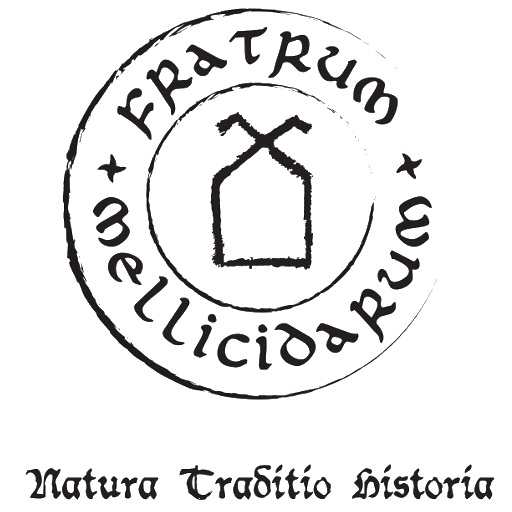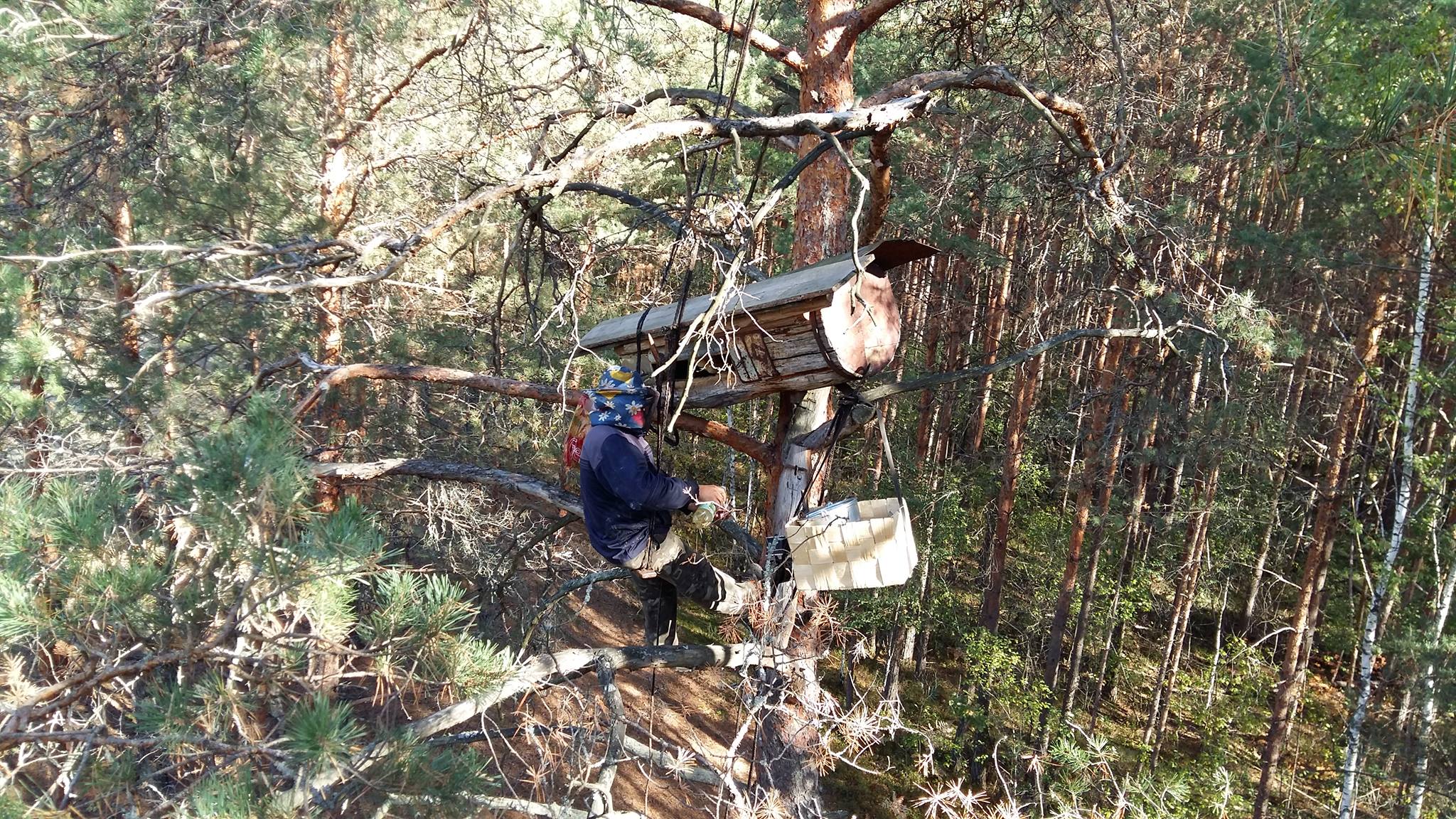Due to its geographical location, tree beekeeping has played an important role in Belarus since at least the Middle Ages. It has been a trade crossroads for merchants travelling from the north (Varangian or Baltic Sea) to the south (Russian or Black Sea) – or from the Vikings to the Greeks – and from the east to the west, following rivers and trails.
Back then, the main export goods were resources obtained from local forests, such as furs, honey and wax. Given the high value of honey and wax, tree beekeeping became a lucrative and independent source of income for the Grand Duchy of Lithuania (GDL; the forerunner of modern Belarus) during the 15th century.
The Grand Duchy of Lithuania joined together with the Kingdom of Poland and was ruled by a common monarch for hundreds of years. The first union in 1386 was sealed with the marriage of the Polish queen and Lithuanian king. The union became official in 1569 and lasted until the end of the 18th century. Together, the bi-confederate state covered an area of up to 900,000 km2, where tree beekeeping was an important part of the economy and social life. The two countries shared and added to their common heritage of ancestors, history, and traditions.

Map of Polish-Lithuanian Commonwealth from 1595. Source: www.antiquariat-krak.com.pl
The gradual development of financial and economic relations led to the active growth of tree beekeeping and its related crafts and industries. Not only was wax but also honey and mead, in high demand within the whole country, as well as abroad.
It should be noted that the evolution of tree beekeeping wasn’t something unique – it was a common practice throughout the entire territory of contemporary Europe. The only difference to today is that during the 15th and 16th centuries, the old forests were cut off from the rest of Europe, the woodworking industry was poorly developed, but tree beekeeping was at its height.
That’s why in the 16th century the Grand Duchy of Lithuania codified a set of laws, which included several articles pertaining to the practice of tree beekeeping, e.g. standards of practice, property rights, obligations and penalities. The majority of the standards and laws of the time, had already been in place and governed by common law and the local courts (assembly of the village community). These had a huge impact on the entire tree beekeeping profession.

Statut Vialikaha Kniastva Litoŭskaha / Статут Вялікага Княства Літоўскага, 3rd edition from 1588.
Only after the partition of the Kingdom of Poland and the Grand Duchy of Lithuania in 1795, and changes to forest management practices, did tree beekeeping gradually start to decline.
Furthermore, bloody wars between the 17th and 18th centuries significantly reduced the population, including the number of professional tree beekeeping members. With the arrival of new technologies and woodworking industries, the tree beekeeping profession was on the verge of extinction. It only existed within small „reserves” that were located in the middle of swamps and old forests (inaccessible areas throughout the territory of modern Belarus).
A brief mention of the tree beekeeping evolution in the territory of Belarus is necessary here. Ancient tree beekeeping developed during the Bronze Age courtesy of the invention of the axe. Then as society developed and the Iron Age ushered in a new kind of instrument, traditional tree beekeeping took over. Later beekeepers started using log hives (instead of tree hives), and finally in the early 20th century, traditional beekeeping (log or tree hive) was brought down to earth with apiaries consisting of log hives at ground level, positioned close to the homes of beekeepers.
It should be noted though that even if each stage of evolution has brought changes, the majority of terminology, methods and equipment have remained the same. For example, the woodpick, axe (‘barta’), rope for climbing (‘liaziva’), basket made from the lime tree (‘lazben’) and some other equipment, are still used according to their original purpose.
At the present stage
The rich traditional culture of tree beekeeping in Belarus has only been recently touched by the long arm of civilisation (good quality roads have only been built in the past 30-40 years). Tree beekeeping is therefore an integral part of everyday life for those who continue its traditions. The main areas where you can still meet not only bees in log hives, but also traditional beekeepers engaged in their craft – are Berascejskaje and Homielskaje Polesie. From a chronological point of view, it was still possible to meet traditional beekeepers in the Haradzenski, Vitebski, Mienski and Mohielevski regions (scattered throughout the territory of Belarus) 30 years ago.
Urbanisation (since the end of the Soviet Union), and the Chernobyl environmental disaster, have had a negative effect on tree beekeeping though, and have greatly reduced the number of traditional beekeepers in Mohielevski, Homielski and Berascejski regions.
Thirty to forty years ago it was possible to find at least one traditional beekeeper in almost every village (there were at least 25,000); today their number does not exceed more than 300. The number of traditional beekeepers (or hereditary beekeepers: where beekeeping is passed down from grandfather to father, from father to son) has gradually decreased.
This has primarily been caused by the natural decline in the number of elderly beekeepers and the lack of basic necessities to engage in a craft which breathes life into rural communities. Earlier tree beekeeping was part of the viable social fabric in a village; a sweet delicacy that provided an additional income. Today, tree beekeeping is basically a part of the traditional culture and source of delicious sweets within a family.
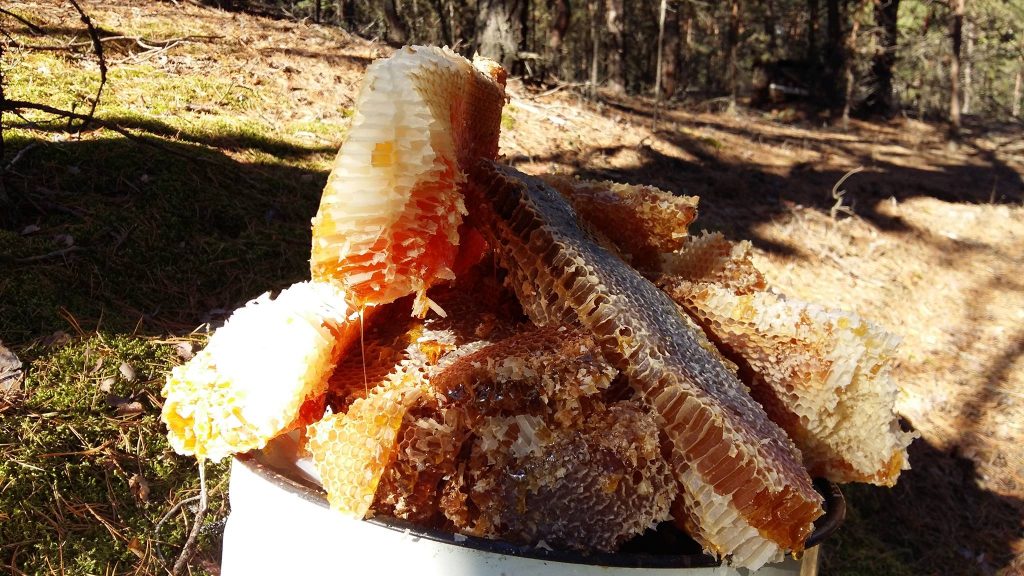
Tree-beekeeping honey (bortny med), an specific now available only for the family and friends of tree-beekeeprs in Belarus. Photo by I. Osipau
Today it is possible to find log hives in the forests, ancestral tools, or the owners themselves. Below is a map of the distribution of information (facts) about tree beekeeping in Belarus.
The map shows that in the Homielski, Berascejski and Mienski regions, the most amount of findings have been located. But only a small number of districts can boast the presence of traditional beekeepers and traditional tree beekeeping methods. Quantitative indicators show that in Belarus today, there are about 14,000 log hives (some of which do not have owners and have not been maintained for over 10-20 years), as well as between 1,800-2,000 (it varies from year to year) log hives settled by bees. As for the tree hive, their number is no higher than 200, with only 50-60 having been settled by bees.

Tree-beekeeping regions in Belarus. Graphic made by I. Osipau.
Melliferous capacity does not exceed 15 kg (for horizontal log hives) and 5 kg for standing log hives. Beekeepers are not able to harvest honey every year either. Today tree beekeeping products are primarily used by beekeepers for their own needs.
Technologies, tools and hives
Analysing the ethnographic material from the mid-19th century to the present day we can say that equipment and technology have not changed much: the basic tool for climbing is a lyaziva; the main device for gouging the log- or tree hives – is a piashnia; a lazben or basket, is used to collect honey, and a smoker (for smoking bees), mask, chisel, manual or electric drill, as well as different types of axes, are still used. Additional tools, such as a chainsaw, have become a mainstay, as they assist in the dirty work of preparing a log hive. A winch is also employed to elevate heavy logs up into the trees.
Large differences among the log hives throughout the territory of Belarus have not been observed. Only minor things have been observed, such as the kind of beehive entrance used, e.g., with a variety of geometric shapes. The beekeeper gouges a kind of pit with a depth of up to 3 cm, as well as 3-5 round holes, into the log hive. In some regions (in the south) there are horizontal log hives, which are located in the trees at a slight angle (up to 20 degrees). The ‘head’ of such log hives is above the “tail”, and a special canopy is placed on top of the log hive. Note: these regions typically follow the practice of every 2nd hive out of 10, being setup vertically; while the rest can be horizontal. The main material used for the hive is pine, but there are also a lot of log hives made of oak. Log hives made of oak have been found – the most recent made 10-15 years ago, and the oldest up to 300 years ago, according to local beekeepers.
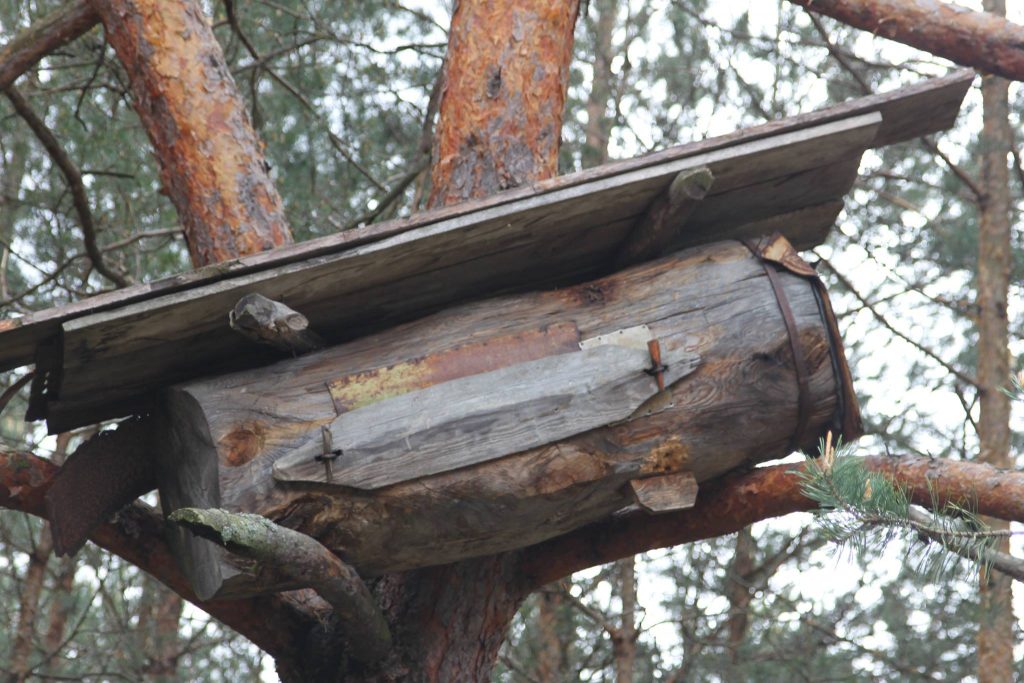
Vertical log hive mounted on the tree with a little angel. Photo. I. Osipau
The dimension of a log hive ranges from 1.2-1.8 m in height, with a thickness of more than 0.5 m (diameter). The internal storage space is shaped more like a trapezoid. The walls of the internal space are curved and a little rounded. The opening comes in a variety of sizes: if it is closed by a bar, then it will have a dimension of up to 70 cm (in height) and up to 20 cm (in width). If the height is more than 70 cm and up to 100 cm, the hole will be closed by 2 bars: a short one of 20-30 cm, and the main bar with a height of up to 70 cm.
Log hives are installed in trees at a height of between 4-12 metres (we haven’t seen hives higher than this). They are secured to the tree with an iron bar or large nails which are driven into the tree (if there are no suitable branches).
Today, Liazeva is not used for climbing, it is used for lowering and attaching oneself to the tree. Today beekeepers use the trunk of the tree (‘Astrou’) or stairs – which allow access to the first strong branch, so that the beekeeper can continue climbing using branches.
Thirty to fifty years ago, the liaziva was used to climb a tree in three different ways (each region had their preference): for raising oneself up, for employing special hinges and for using cups.
Today in Belarus, two types of liaziva are used for attaching and lowering oneself in a tree: one of leather (Buckskin) and one of rope (hemp), the wooden parts of the structure are almost the same.
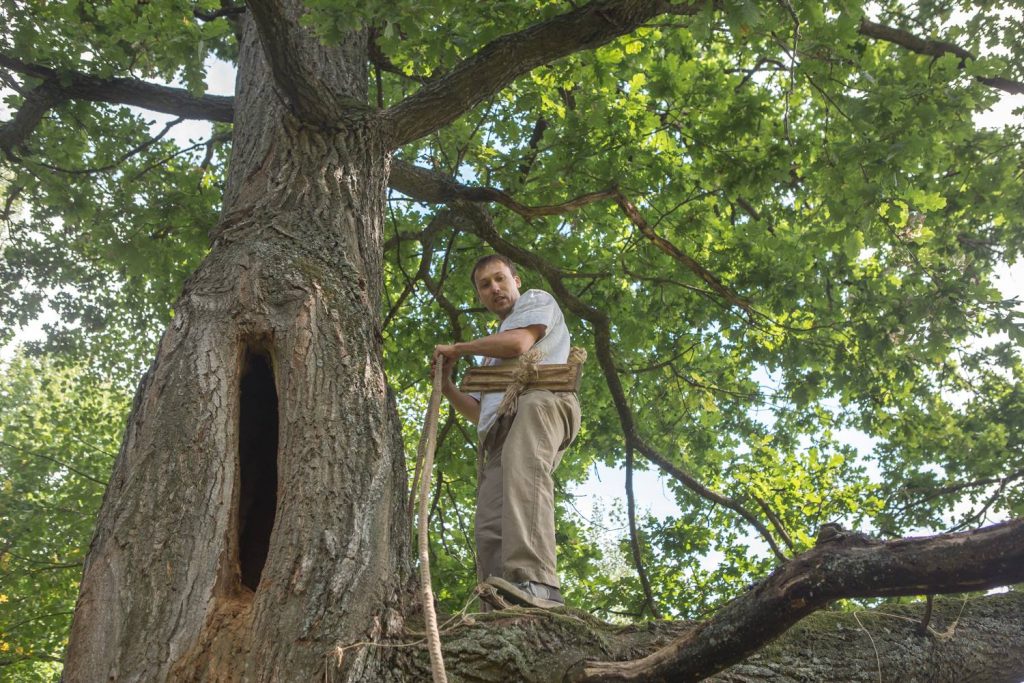
Author on the old tree-hive oak tree.
Today tree-beekeeper working process
Every year, the tree beekeeping season starts, as soon as the weather starts getting warmer. This is when the beekeeper inspects his or her log hives. If any hives and bees have died during the winter, the beekeeper cleans out the internal space by sweeping it. If the honeycomb has been damaged then the beekeeper leaves the log hive open and waits for the birds to eat it clean (this can take up to one year). Once the log hive is clean, but there are no bees, the beekeeper starts to attract new settlers. They use their own recipe, which includes fragrant herbs and liquids. It is customary to wait until the 25th of May, after which the bees will come. Also at this time each beekeeper repairs their log hives (if they are damaged), or elevates new ones into the trees, and repeats the baiting process.
Tree beekeepers manage around six log hives, and can elevate around 2-3 in one day.
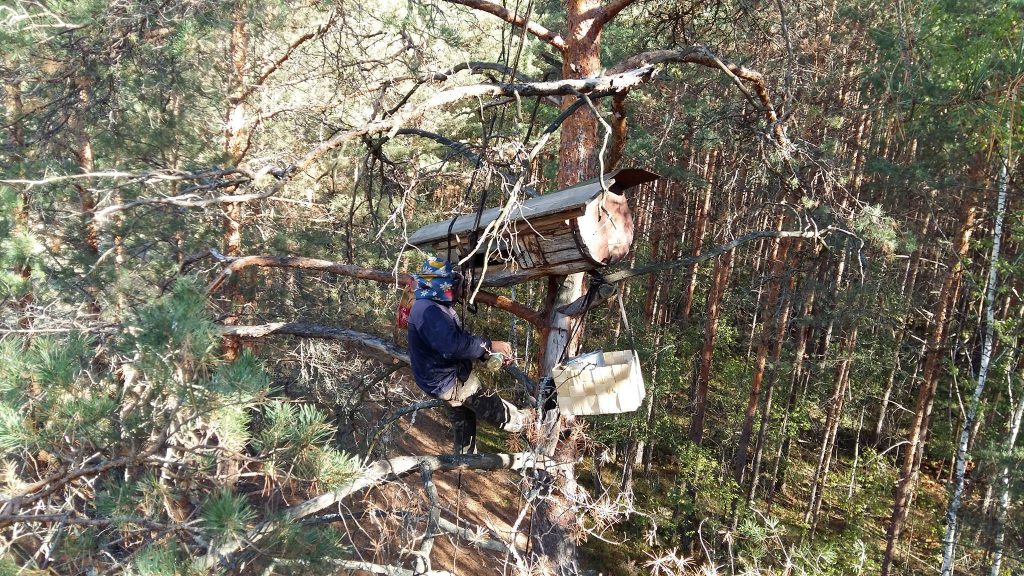
Tree-beekeeper at work in Belarus. Some of the logs here are putted on tree vertically. Photo by I. Osipau
After this heavy work, the tree beekeeper only observes and cautiously approaches their log hives. In autumn, after the leaves have fallen, the tree beekeeper will collect some honey (the largest part or about 2/3 of the honey is left for the bees), and the log hive is not treated with any heating procedure.
The collected honey is preserved in honeycombs. Clean and dry cells are used in the manufacturing of wax candles.
At this time, new log hives are built.
Traditional craft
Today, tree beekeeping is a complex part of the traditional Belorussian culture. It is equal parts physical, traditional and spiritual. Only the most dedicated tree beekeepers carry on these traditions, carefully protecting its secrets and skills.
There is increasing interest among urban dwellers and rural youths though. However, only a select few are chosen as apprentices and bearers of the traditions which have survived until today.
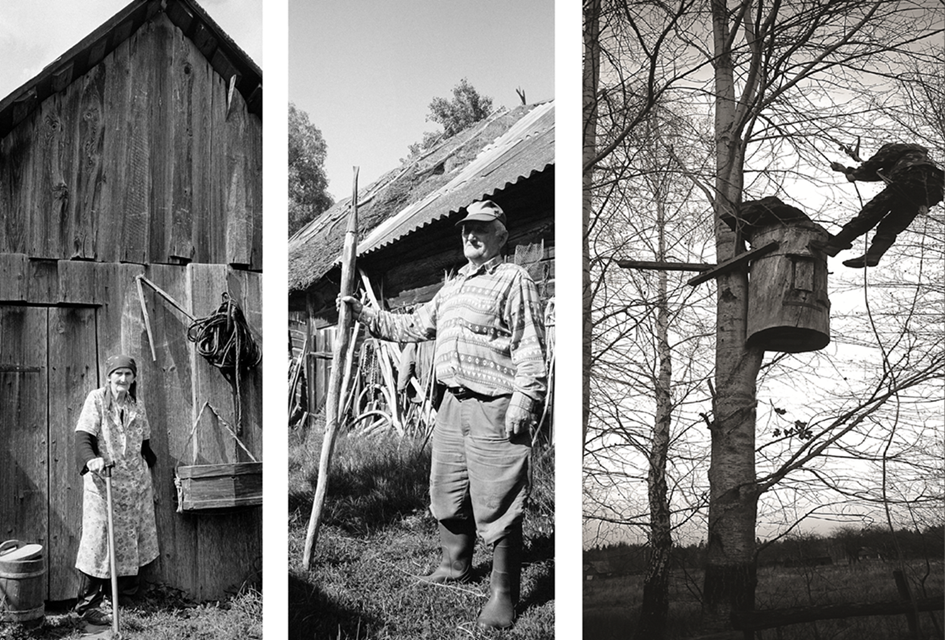
Tree-beekeepers portraits from Belarus. Photos by prof. K. Hejke
Recent future
Tree beekeeping traditions need to be carefully transferred from the past to the present and into the future using gentle measures to preserve best practices, traditional knowledge and skills. The longevity of its traditions is in the hands of today’s generation.
It is necessary to preserve our history and restore old ties, as well as partnerships, not only within a country, but also across neighbouring regions – such as the territory of the former Commonwealth (then the Crown of the Kingdom of Poland and the Grand Duchy of Lithuania) – which are now for the most part occupied by Belarus, Poland and Ukraine. In 2016, initiators from these three countries began a joint project.
The project’s aim is to preserve and promote the cultural and historical heritage of tree beekeeping within the shared territories. In other words, the preservation of the common tree beekeeping traditions shared by the PL-BYUA (the nations of the former Polish-Lithuanian Commonwealth).
This cross border approach to tree beekeeping is necessary, as all previous tree beekeeping projects in Poland have been focused on the Bashikians traditions and their way of tree beekeeping, which is different to the one preserved in the project’s area.
In the territories of Belarus and the Ukraine, this is the first project that focuses on the preservation and promotion of their tree beekeeping traditions. Therefore the project is dedicated to showing and promoting every aspect of the history and traditions that unite the region.
Author: Ivan Osipau (Barefooted tree-beekeepers Brotherhood), XII 2016, editor Piotr Pilasiewicz
Zrealizowano w ramach stypendium Ministra Kultury i Dziedzictwa Narodowego.


